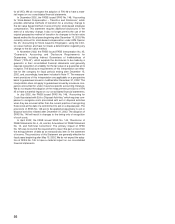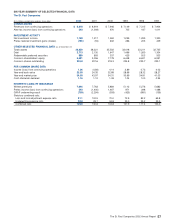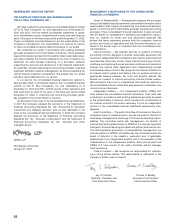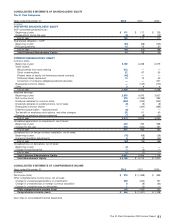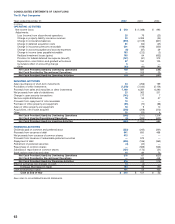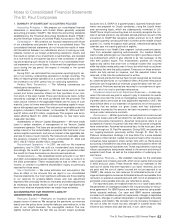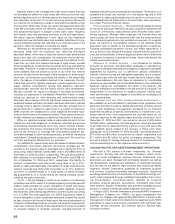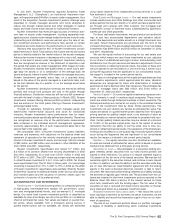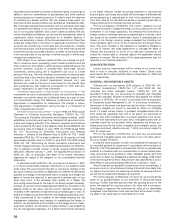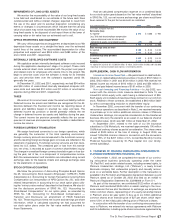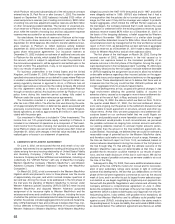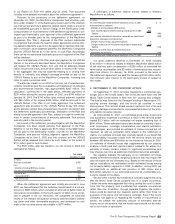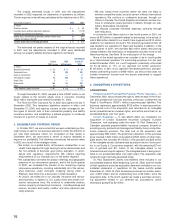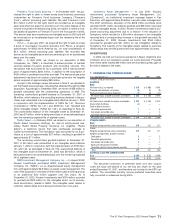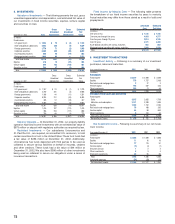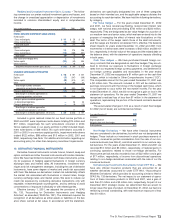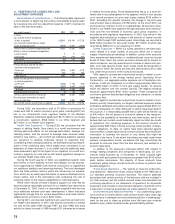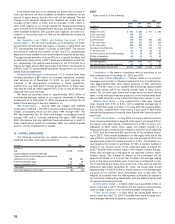Travelers 2002 Annual Report Download - page 68
Download and view the complete annual report
Please find page 68 of the 2002 Travelers annual report below. You can navigate through the pages in the report by either clicking on the pages listed below, or by using the keyword search tool below to find specific information within the annual report.
should be sold to achieve our primary investment goals of assuring our
ability to meet our commitments to policyholders and other creditors
and maximizing our investment returns. In order to meet the objective
of maintaining a flexible portfolio that can achieve these goals, our
fixed income and equity portfolios are classified as “available-for-sale.”
We continually evaluate these portfolios, and our purchases and sales
of investments are based on our cash requirements, the characteris-
tics of our insurance liabilities, and current market conditions. We also
monitor the difference between our cost and the estimated fair value of
investments, which involves uncertainty as to whether declines in
value are temporary in nature. At the time we determine an “other than
temporary” impairment in the value of a particular investment to have
occurred, we consider the current facts and circumstances, including
the financial position and future prospects of the entity that issued the
investment security, and make a decision to either record a write-down
in the carrying value of the security or sell the security; in either case,
recognizing a realized loss.
With respect to our venture capital portfolio, we manage our port-
folio to maximize return, evaluating current market conditions and the
future outlook for the entities in which we have invested. Because this
portfolio primarily consists of privately-held, early-stage venture
investments, events giving rise to impairment can occur in a brief
period of time (e.g., the entity has been unsuccessful in securing addi-
tional financing, other investors decide to withdraw their support, com-
plications arise in the product development process, etc.), and
decisions are made at that point in time, based on the specific facts
and circumstances, with respect to a recognition of “other than tem-
porary” impairment, or sale of the investment.
Unrealized Appreciation or Depreciation on Investments — For
investments we carry at estimated fair value, we record the difference
between cost and fair value, net of deferred taxes, as a part of com-
mon shareholders’ equity. This difference is referred to as unrealized
appreciation or depreciation on investments. The change in unreal-
ized appreciation or depreciation during the year is a component of
other comprehensive income.
Derivative Financial Instruments — In June 1998, the FASB issued
Statement of Financial Accounting Standards ("SFAS") No. 133,
“Accounting for Derivative Instruments and Hedging Activities,” which
establishes accounting and reporting standards for derivative instru-
ments and hedging activities. This statement required all derivatives
to be recorded at fair value on the balance sheet and established new
accounting rules for hedging. In June 1999, the FASB issued SFAS
No. 137, “Accounting for Derivative Instruments and Hedging
Activities — Deferral of the Effective Date of SFAS No. 133, " which
amended SFAS No. 133 to make it effective for all quarters of fiscal
years beginning after June 15, 2000. In June 2000, the FASB issued
SFAS No. 138, “Accounting for Certain Derivative Instruments and
Certain Hedging Activities,” as an additional amendment to SFAS No.
133, to address a limited number of issues causing implementation
difficulties. Effective January 1, 2001, we adopted the provisions of
SFAS No. 133, as amended. See Note 10 for further information
regarding the impact of the adoption on our consolidated financial
statements.
In accordance with SFAS No. 133, our policy as of January 1, 2001
is to record all derivative financial instruments on our balance sheet
at fair value.The accounting for the gain or loss due to changes in the
fair value of these instruments is dependent on whether the derivative
qualifies as a hedge. If the derivative does not qualify as a hedge, the
gains or losses are reported in earnings as a realized gain or loss
when they occur. If the derivative does qualify as a hedge, the
accounting varies based on the type of risk being hedged. Generally,
however, the portion of the hedge deemed effective is recorded on the
balance sheet at fair value, and the portion deemed ineffective is
recorded in the statement of operations as a realized gain or loss. To
qualify for hedge accounting treatment, the hedging relationship is for-
mally documented at the inception of the hedge detailing the risk
management objectives and strategy for undertaking the hedge. In
addition, we assess both at the inception of the hedge and on a quar-
terly basis, whether the derivative is highly effective in accomplishing
the risk management objectives. If it is determined that the derivative
66
is not highly effective, hedge accounting treatment is discontinued
and any gains and losses associated with the hedge’s ineffectiveness
are recognized as a realized gain or loss in the statement of opera-
tions. Fair value for our derivatives is based on quoted market rates or
models obtained from third party pricing services.
Prior to our adoption of SFAS No. 133 in 2001, related to our use
of forward contracts to hedge the foreign currency exposure to our net
investment in our foreign operations, we reflected the movements of
foreign currency exchange rates as unrealized gains or losses, net of
tax, as part of our common shareholders’ equity. If unrealized gains or
losses on the foreign currency hedge exceeded the offsetting cur-
rency translation gain or loss on the investments in the foreign opera-
tions, they were included in the statement of operations. Related to
our use of interest rate swap agreements to manage the effect of
interest rate fluctuations on some of our debt and investments, we
netted the interest paid or received against the applicable interest
expense or income. The fair value of the swap agreements was not
reflected in our financial statements.
CASH RESTRICTIONS
Lloyd’s solvency requirements call for certain of our funds to be
held in trust in amounts sufficient to meet claims. These funds
amounted to $167 million and $76 million at December 31, 2002 and
2001, respectively.
GOODWILL AND INTANGIBLE ASSETS
Effective with our first-quarter 2002 adoption of SFAS No. 141,
“Business Combinations” (“SFAS No. 141”) and SFAS No. 142,
“Goodwill and Other Intangible Assets,” (“SFAS No. 142”) as
described in Note 22, our accounting for goodwill and intangible
assets has changed. (Nuveen Investments had applied the relevant
provisions of SFAS No. 141 in 2001 in connection with its acquisition
of Symphony Asset Management LLP). In a business combination,
the excess of the amount we paid over the fair value of the acquired
company’s tangible net assets is recorded as either an intangible
asset, if it meets certain criteria, or goodwill. Intangible assets with a
finite useful life (generally over four to 20 years) are amortized to
expense over their estimated life, on a basis expected to be consis-
tent with their estimated future cash flows. Intangible assets with an
indefinite useful life and goodwill, which represents the excess pur-
chase price over the fair value of tangible and intangible assets, are
no longer amortized, effective January 1, 2002, but remain subject to
tests for impairment.
Prior to the adoption of SFAS Nos. 141 and 142, we amortized
goodwill and intangible assets over periods of up to 40 years, gener-
ally on a straight-line basis.
During the second quarter of 2002, we completed the evaluation of
our recorded goodwill for impairment in accordance with provisions of
SFAS No. 142.That evaluation concluded that none of our goodwill was
impaired. In connection with our reclassification of certain assets previ-
ously accounted for as goodwill to other intangible assets with finite
useful lives in 2002, we established a deferred tax liability of $6 million
in the second quarter of 2002.That provision was classified as a cumu-
lative effect of accounting change effective as of January 1, 2002.
We will evaluate our goodwill for impairment on an annual basis. If
an event occurs or circumstances change that would more likely than
not reduce the fair value of a reporting unit below its carrying amount,
we will test for impairment between annual tests.
Prior to the adoption of SFAS Nos. 141 and 142, we monitored the
value of our goodwill based on our estimates of discounted future
earnings. If either estimate was less than the carrying amount of the
asset, we reduced the carrying value to fair value with a correspon-
ding charge to expense. We monitored the value of our identifiable
intangibles to be disposed of and reported them at the lower of carry-
ing value or fair value less our estimated cost to sell.


